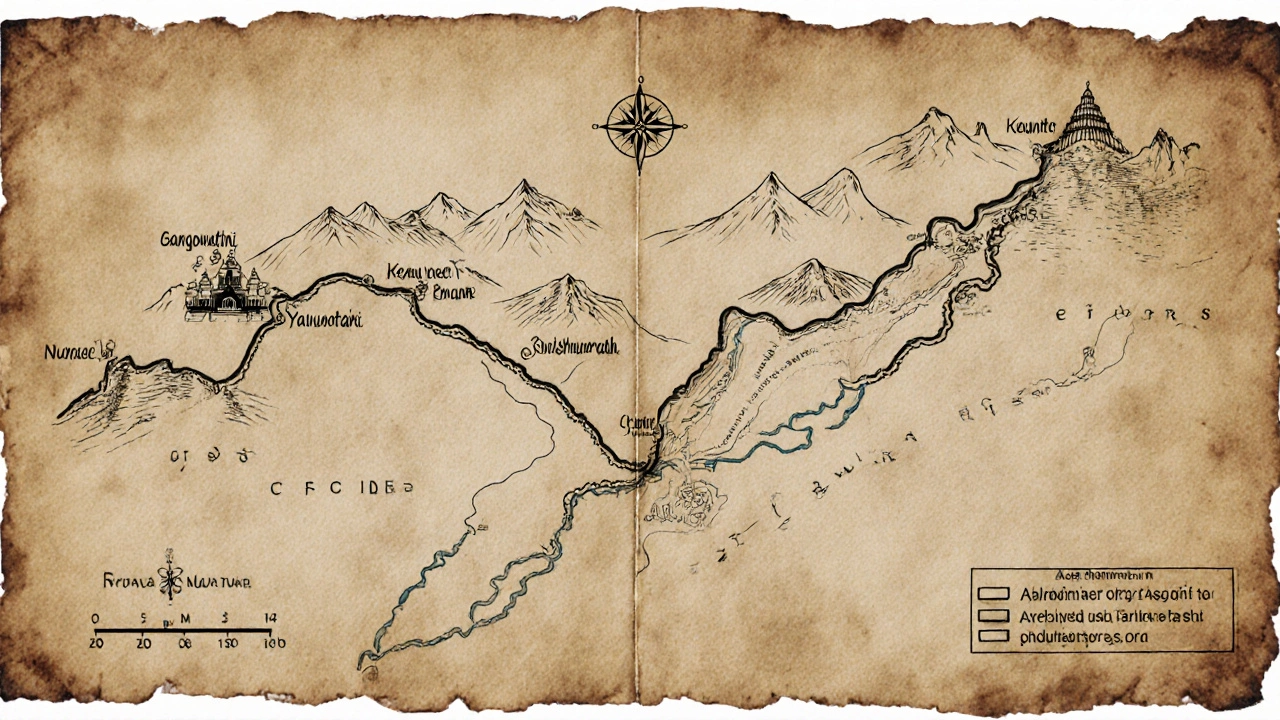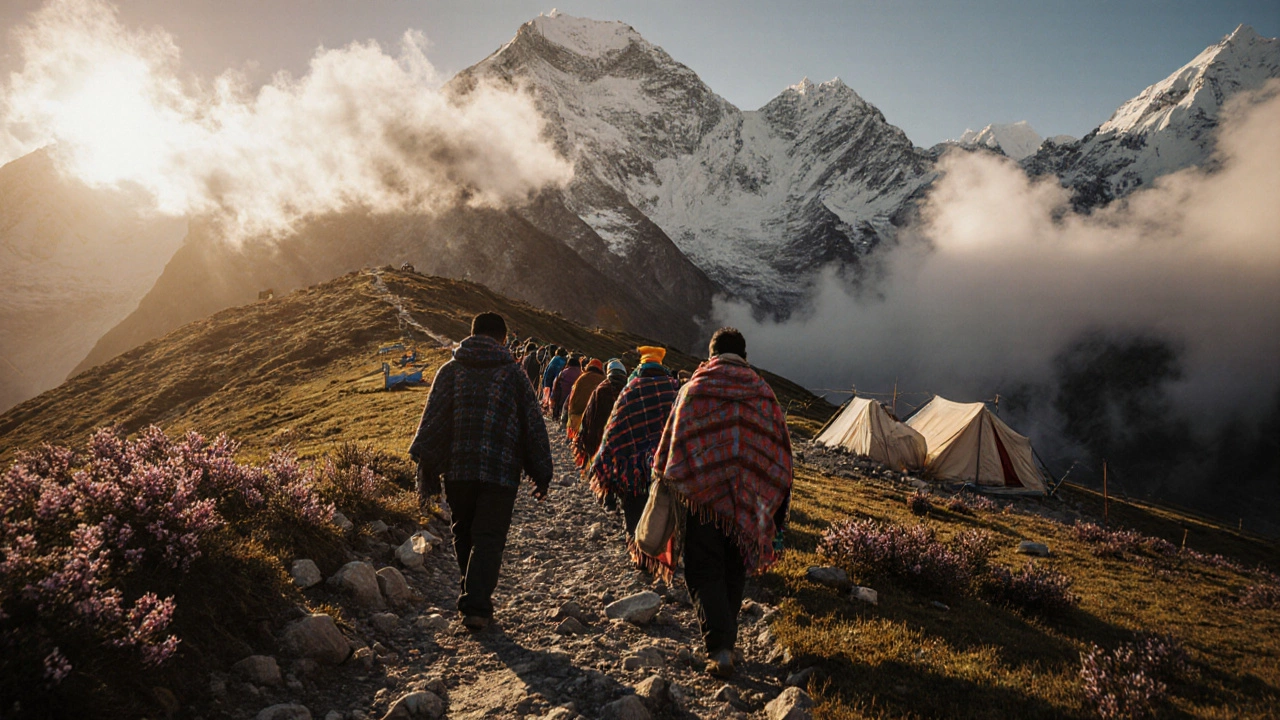Why Kedarnath Isn't Part of the Char Dham Pilgrimage

- Oct, 17 2025
- 0 Comments
- Aaron Blackwood
Char Dham Pilgrimage Planner
Understanding Char Dham
This interactive tool helps you compare the traditional Char Dham with the modern version that includes Kedarnath. Learn how historical context and modern tourism have shaped these sacred sites.
Traditional Char Dham
Original 8th CenturyThe pilgrimage route established by Adi Shankaracharya in the 8th century
Four sites:
- Badrinath (Vishnu)
- Gangotri (Ganga)
- Yamunotri (Yamuna)
- Rameswaram (Shiva) or Tirupati
Key characteristic: Spiritual representation of all four cardinal directions of India
Modern Char Dham
Uttarakhand Tourism InitiativeA recent addition to the pilgrimage circuit promoted by tourism authorities
Four sites:
- Badrinath (Vishnu)
- Gangotri (Ganga)
- Yamunotri (Yamuna)
- Kedarnath (Shiva)
Key characteristic: Focuses on four high-altitude sites in Uttarakhand
Key Differences
Pilgrimage Planner
Calculate the ideal itinerary for visiting the four northern shrines
Recommended Itinerary
Arrive in Dehradun, travel to Haridwar, and acclimatize at the holy city of Rishikesh
Visit Gangotri, the source of the Ganges River, and experience the sacred pilgrimage
Visit Yamunotri, the source of the Yamuna River, and learn about its spiritual significance
Visit Badrinath, dedicated to Lord Vishnu, and experience the Himalayan pilgrimage
Travel to Kedarnath, the highest of the four shrines, requiring a trek. Book Gaurikund accommodation in advance.
When you hear about the Kedarnath is a revered Hindu shrine dedicated to Lord Shiva, perched at 3,583 metres in the Garhwal Himalayas, it’s natural to ask why it isn’t listed among the iconic four sites of the Char Dham the quartet of pilgrimage destinations traditionally identified by Adi Shankaracharya in the 8th century. The short answer lies in history, geography, and the way the pilgrimage tradition was codified centuries ago.
What the Char Dham Actually Means
The term "Char Dham" literally translates to "four abodes". It refers to the four holy shrines that Adi Shankaracharya the 8th‑century philosopher‑saint who unified Hindu doctrine designated to give devotees a spiritual tour of the four cardinal directions of India. These are:
| Site | Deity | State | Elevation (m) |
|---|---|---|---|
| Badrinath | Vishnu | Uttarakhand | 3,300 |
| Gangotri | Ganga (daughter of Shiva) | Uttarakhand | 3,100 |
| Yamunotri | Yamuna (daughter of Shiva) | Uttarakhand | 3,293 |
| Kedarnath | Shiva | Uttarakhand | 3,583 |
Notice that Kedarnath appears in the table, but it is placed in a separate column because its status has shifted over time. Historically, only Badrinath, Gangotri, and Yamunotri were the original Char Dham.
How the Original Char Dham Was Formed
Adi Shankaracharya’s main goal was to offer a spiritual circuit that covered the north, south, east, and west of the subcontinent. He selected sites that already enjoyed centuries‑old worship and that were reasonably accessible from a central point. The three Himalayan shrines-Gangotri, Yamunotri, and Badrinath-represent the northern quadrant, while the fourth site originally lay in the south: Rameswaram a Shiva temple in Tamil Nadu. Over the centuries, the southern spot was replaced by the more famed Tirupati the Venkateswara temple in Andhra Pradesh in popular lore, but the traditional pilgrimage route retained the label “Char Dham”.
Because Kedarnath sits close to Badrinath (just a couple of hours’ trek away), many modern travelers lump it together with the three northern shrines, branding the group as the “Char Dham of Uttarakhand”. Yet, from a strict doctrinal perspective, Kedarnath never received the official seal from Shankaracharya.
Geography and Accessibility: Why Kedarnath Was Overlooked
Kedarnath is tucked deep inside the Garhwal Himalayas a rugged sub‑range of the western Himalaya in Uttarakhand. The temple only becomes reachable during the short summer window (late May to early October) when the treacherous snow‑bound roads open. In contrast, Gangotri, Yamunotri, and Badrinath have relatively easier road access via the national highway that runs through Devprayag and Joshimath.
When Shankaracharya drew the map, ease of pilgrimage was a practical concern. The ancient routes relied on footpaths and horseback trails, not modern highways. Including a site that demanded a multi‑day trek through a glacier would have made the entire Char Dham circuit too arduous for the average devotee of his era.

Historical Records and Sacred Texts
Old scriptures such as the Skanda Purana one of the largest Mahapuranas, describing many Himalayan shrines mention Gangotri, Yamunotri, and Badrinath explicitly as part of the pilgrimage sequence. Kedarnath, while praised as “the abode of the mighty Lord Shiva”, appears later in medieval travelogues like the Rashtriya Yatra by the 16th‑century pilgrim Baba Budhananda a noted trekker who documented Himalayan routes. The delay in textual endorsement explains why official lists kept Kedarnath out of the core quartet.
Modern Tourism and the “Uttarakhand Char Dham” Trend
In the last two decades, the Indian tourism board has packaged the four Himalayan shrines-Gangotri, Yamunotri, Kedarnath, and Badrinath-under a single promotional banner called the “Uttarakhand Char Dham”. The move was meant to boost pilgrim footfall and simplify travel itineraries. As a result, many travel agencies now offer a combined tour that covers all four sites in a single trip, often labeling it as the “Char Dham Yatra”.
While this marketing strategy works well for visitors, it blurs the historical line between the traditional Char Dham and the newer grouping. That’s why you’ll hear both answers to the question: some say Kedarnath is part of the Char Dham, while scholars point out the original designation excluded it.
Key Differences Between the Traditional and Modern Char Dham
- Origin: Traditional Char Dham stems from Adi Shankaracharya’s 8th‑century vision; modern version is a tourism initiative launched in the early 2000s.
- Geographical Spread: The original includes a southern site (Rameswaram/Tirupati); the modern version clusters all four sites in the north.
- Seasonality: Kedarnath’s access is limited to the monsoon‑free months, whereas the older sites have longer open periods.
- Spiritual Emphasis: Shankaracharya’s route sought balanced representation of the four cardinal deities; the modern tour emphasizes the “Shiva‑Vishnu” duo of Kedarnath and Badrinath.

Practical Tips for Pilgrims Who Want All Four Northern Shrines
- Plan for a 10‑12 day itinerary: Arrive in Dehradun, travel to Haridwar, then to Rishikesh, before heading to the hill stations.
- Book accommodation in Gaurikund the base camp for the Kedarnath trek well in advance; it fills up quickly during the summer window. \n
- Carry warm clothing and waterproof gear; even July evenings can drop below 10°C at 3,500m.
- Acclimatize at Joshimath the gateway town for Badrinath and the higher altitude trek before tackling higher altitudes.
- Hire a licensed guide for the Kedarnath trek; the trail involves steep ascents and occasional rockfalls.
Following this checklist ensures you cover the four northern shrines without missing out on the spiritual depth each offers.
Conclusion: The Answer in One Sentence
Kedarnath is not part of the original Char Dham because Adi Shankaracharya’s historic pilgrimage circuit excluded it, but modern tourism in Uttarakhand now treats it as a fourth Himalayan site, creating two parallel definitions that coexist today.
Frequently Asked Questions
Is Kedarnath considered a Char Dham pilgrimage?
Historically, no. The original Char Dham was defined by Shankaracharya and did not include Kedarnath. Today, many tour operators label the four Uttarakhand shrines as a “Char Dham”, so the answer depends on context.
When is the best time to visit Kedarnath?
The temple opens from late May to early October, after the snow melts. Mid‑June to early September offers the most stable weather.
How long does the Kedarnath trek take?
From Gaurikund to Kedarnath Temple it’s a 16‑km hike, usually completed in 6‑8 hours for average trekkers.
Can I combine Kedarnath with the other three northern shrines in one trip?
Yes. Most itineraries allocate 10‑12 days, starting with Gangotri, then Yamunotri, followed by Kedarnath and Badrinath, usually via Joshimath as a base.
Why did the southern Char Dham site change over time?
Shankaracharya originally chose Rameswaram for the southern point. Over centuries, pilgrim preferences shifted toward Tirupati because of its massive fame and better accessibility, though the formal list still references the original.